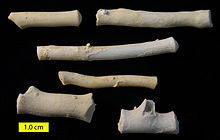
Octocorallia is a class of Anthozoa comprising over 3,000 species of marine organisms formed of colonial polyps with 8-fold symmetry. It includes the blue coral, soft corals, sea pens, and gorgonians within three orders: Alcyonacea, Helioporacea, and Pennatulacea. These organisms have an internal skeleton secreted by mesoglea and polyps with eight tentacles and eight mesentaries. As with all cnidarians these organisms have a complex life cycle including a motile phase when they are considered plankton and later characteristic sessile phase.

Acanella is a genus of deep sea bamboo coral of the family Keratoisididae. Acanella are mainly studied and found in Hawaii, they are able to survive in high-flow sites and are preyed upon by nudibranch mollusks. It has a high fecundity and small size that allows high dispersal and recruitment; however, it has been classified as a vulnerable marine organism due to its vulnerability to bottom fishing gear.

Lepidisis is a genus of deep-sea bamboo coral in the family Keratoisididae.

Scleraxonia is a suborder of corals, a member of the phylum Cnidaria.

Holaxonia is a suborder of soft corals, a member of the phylum Cnidaria. Members of this suborder are sometimes known as gorgonians and include the sea blades, the sea fans, the sea rods and the sea whips. These soft corals are colonial, sessile organisms and are generally tree-like in structure. They do not have a hard skeleton composed of calcium carbonate but have a firm but pliable, central axial skeleton composed of a fibrous protein called gorgonin embedded in a tissue matrix, the coenenchyme. In some genera this is permeated with a calcareous substance in the form of fused spicules. Members of this suborder are characterized by having an unspiculated axis and often a soft, chambered central core. The polyps have eight-fold symmetry and in many species, especially in the families Gorgoniidae and Plexauridae, contain symbiotic photosynthetic algae called zooxanthellae. These soft corals are popular in salt water aquaria.

Gorgoniidae is a family of soft corals, a member of the subclass Octocorallia in the phylum Cnidaria. Nearly all the genera and species are native to the east and west coasts of America.

Melithaea is a genus of octocorals in the family Melithaeidae. Members of the genus are commonly known as fan corals and are found in the tropical Indo-Pacific region. The type species is Melithaea ochracea.

Dendronephthya is a genus of soft corals in the family Nephtheidae. There are over 250 described species in this genus. They are sometimes kept in aquariums, but are notoriously difficult to keep, requiring a near constant supply of small foods such as phytoplankton.

Alcyonium is a genus of soft corals in the family Alcyoniidae and class octocorallia. Alcyonium generally called as dead men's finger.

Plexauridae is a family of marine colonial octocorals in the phylum Cnidaria. Members of this family are found in shallow tropical and subtropical seas. Many species contain symbiotic photosynthetic protists called zooxanthellae.

Siphonogorgia is a genus of soft corals in the family Nidaliidae. Like other members of this family, these corals do not contain symbiotic zooxanthellae.

Anthomastus is a genus of soft corals in the family Alcyoniidae.

Ellisella, commonly known as sea whip, is a genus of soft coral in the family Ellisellidae.

Clavularia is a genus of corals in the family Clavulariidae. They are often referred by the common names star polyps or clove polyps.

Litophyton is a genus of soft corals in the family Nephtheidae.

Chrysogorgia is a genus of soft corals in the family Chrysogorgiidae.

Iciligorgia is a genus of soft coral in the family Anthothelidae.
Villagorgia is a genus of gorgonian-type octocorals in the family Plexauridae.

Narella is a genus of deep-sea soft corals in the family Primnoidae (Milne Edwards, 1857). They are sessile, bottom-dwelling organisms that can be found in all ocean basins, having cosmopolitan distribution. They have a branching appearance.


















